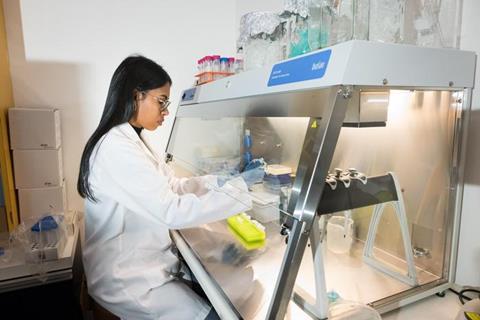A Wits University research team has developed engineered TALENs—precision ‘molecular scissors’—that can permanently disable the genetic blueprint of the hepatitis B virus (HBV). The approach directly targets covalently closed circular DNA (cccDNA), the stubborn viral reservoir that current therapies cannot eliminate.

This highlights an important preclinical model that could be successful in humans. The notoriously persistent, difficult-to-treat, lifelong and contagious virus – which insidiously attacks the liver – infects millions, particularly those with compromised immune systems and children. Globally, over 296 million people are infected, with many living in South Africa.
READ MORE: siRNA plus nanovaccine yields stable functional cure for chronic hepatitis B
READ MORE: Interventions could eliminate transmission of hepatitis B from mothers to babies in Africa
Dr Tiffany Smith, a postdoctoral research fellow at the Antiviral Gene Therapy Research Unit (AGTRU) in the University of the Witwatersrand, has developed an innovative solution to tackle this challenge. She used a gene-editing technology called TALENs (transcription activator-like effector nucleases) to precisely and permanently disable the virus’s hidden genetic material.
Unlike the CRISPR-based approaches, TALENs do not require guide RNAs and are highly effective even in complex or tightly packed DNA regions.
The study is published in the journal Viruses.
Cracking the cccDNA problem
The key innovation lies in targeting covalently closed circular DNA (cccDNA), the viral ‘mini chromosome’ that makes HBV so difficult to cure. Medications can suppress HBV activity but cannot eliminate this stubborn form of viral DNA, which hides inside infected liver cells and fuels relapse when treatment stops.
Smith’s ’molecular scissors’ are designed to cut and inactivate HBV cccDNA, something that has long frustrated scientists. “The ability to target the virus’s genetic blueprint directly paves the way for reduced healthcare costs and dramatically improved outcomes,” she says.
Hepatitis B is a major health issue in South Africa, where it contributes to severe conditions such as cirrhosis and liver cancer. Current treatments require lifelong use, which is an especially heavy burden in resource-limited settings. The disease is particularly devastating for children, whose immature immune systems cannot fight off infection. Although safe, effective vaccines have been available since 1995, coverage gaps mean many remain unprotected.
Early results show promise
Laboratory tests on cultured human liver cells showed that the treatment reduced hepatitis B markers by 80%. In HBV-infected mice, a single dose resulted in a 99% reduction in circulating viral DNA. Importantly, the therapy was well tolerated, causing only mild inflammation that quickly resolved with no significant toxicity.
“These results are highly promising,” says Professor Patrick Arbuthnot, who leads the AGTRU team. “This work underscores the enormous potential of gene-editing technologies to confront persistent viral infections with precision and safety.”
Smith and her team specialise in delivering mRNA in lipid nanoparticles, a platform that has already transformed vaccine development. By combining this delivery system with the precision of TALEN-based molecular scissors, they have taken an important step towards a functional cure for HBV.
For clinical use, it is important to show that these TALENs can accurately target viral DNA while causing few or no changes to the host’s DNA. However, the ability to directly cut and disable HBV’s hidden genetic blueprint, especially its stubborn cccDNA, represents a milestone in the global effort to eliminate hepatitis B.







No comments yet